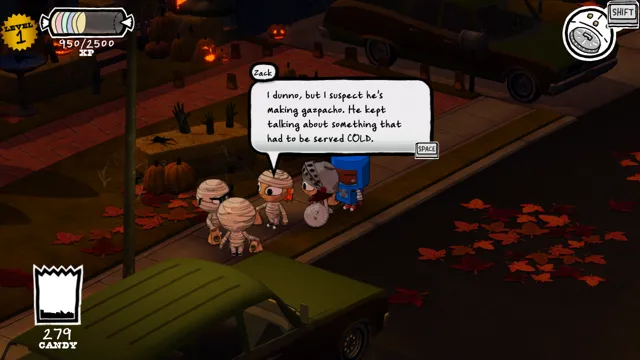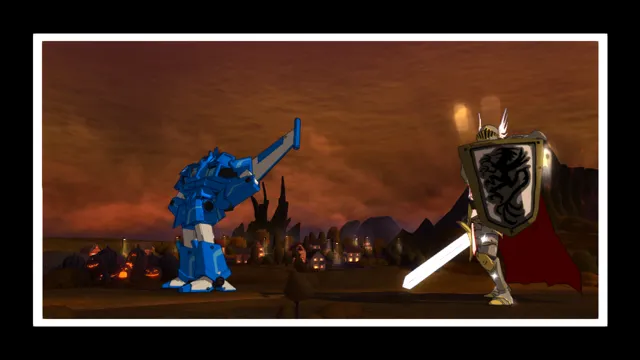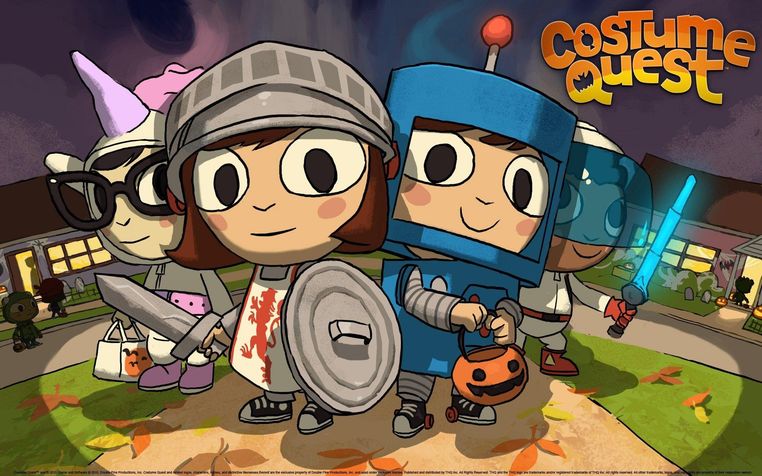Costume Quest
Ah, Double Fine. We have a long and complex relationship, you and I. I consistently look forward to playing Double Fine games, and then, inevitably, I find myself disappointed. By the time I got to Costume Quest, I’d tempered my expectations. I knew I would get a cute game that I would be fond of, but which somehow would manage to be all style and muck up its main substance.
Oh Double Fine. We understand each other so well.
 The writing will always make me laugh.
The writing will always make me laugh.
Costume Quest is an adventure RPG. Players play as one of a pair of twins - Wren or Reynold - caught up in shenanigans as they go trick-or-treating. When one of the twins is abducted by monsters, it’s up to the remaining twin to don a variety of costumes, explore the neighbourhood, and find a way to rescue them.
Costume Quest’s mechanics rely on characters wearing a variety of costumes, most of which grant a special ability in-world. The robot costume, for example, includes wheels, allowing a player to fly off ramps and access new areas. The knight’s shield protects from environmental hazards, and the space warrior’s sword lights up the dark. This use of costumes in the world does wonders for the game’s atmosphere and overall feel, crafting an experience that feels less like a traditional RPG, and more like an exploration of a child’s imagination. These costumes have these abilities, not because they objectively exist, but because the child wearing the costume believes in the power of that costume enough to give it power. It’s genuinely wholesome, and I enjoyed reliving my own experiences dressing up in different costumes as a child.
Coupled with the in-world abilities of the costumes, each costume also grants special abilities in combats. Combats consist of costumed children fighting monsters, their costumes becoming the things they represent. The robot becomes a gundam, for example, and the knight becomes a giant crusader. It is, again, a fantastic exploration of imagination, as the children’s belief in the costumes grants them the ability to overcome the enemies before them. Combat is fairly simple, with characters having the ability to attack, run, or, after several turns, use their special attack. These are then powered up through quicktime events. Enemies’ attacks can also be dodged through similar quicktime events.
 This is my favourite costume.
This is my favourite costume.
This theme of exploring children’s imaginations continues through the game, with both positive and negative elements. As fantastic as it is for the look and feel of the game, the mechanics themselves get deeply tedious. This is especially true of combats, where the simple mechanics don’t allow for strategy. Whether I succeeded at a combat or not was less a product of my decisions and how I approached fight, and was instead the result of whether I could push the correct button in time. Mechanics like these don’t necessarily make sense within a broader RPG, or even within a turn-based RPG. In those combats, planning fights and having options are key. These mechanics do, however, make sense within the context of a child’s world, one where smashing toys against each other and saying “pew pew!” counts as combat. The game asks the player to re-embody that sense of child-like wonder and naivety through its combat and quest system. The reality, however, is that I am not a child anymore. I’m an adult, and combat without tactics feels hollow and dull. Imagination alone is not enough to give meaning.
 It is nice to imagine, though.
It is nice to imagine, though.
In the end, then, the question of Costume Quest’s success as a game is less a question about the game itself, and more about the player and what they want to get out of a game. Its mechanics are tedious and a slog, but its world is funny and charming. Combat is mind-numbingly simplified and left more or less to chance, but the quest itself is a lovely exploration of imagination and what Halloween actually means to a child. In many ways, this feels not like a game for children, but a game for players who want to re-experience what it is to be a child, both within and without the game. It requires the mindset of innocent creativity to truly shine, and that mindset can be difficult to achieve. Without that lens, however, Costume Quest falls flat, and becomes a slog through someone else’s imagination.
Developer: Double Fine Productions
Genre: Adventure
Year: 2011
Country: United States
Language: English
Play Time: 4-5 Hours
Youtube: https://youtu.be/Nu6gcj17ujs
